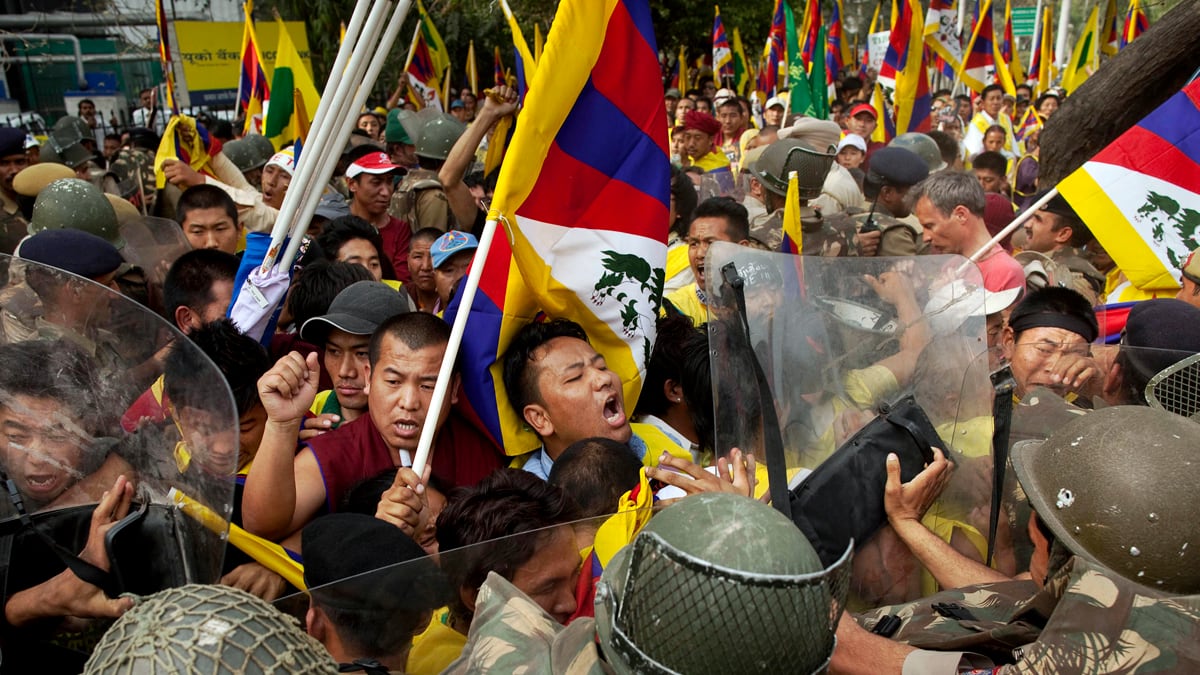Like Tibetan neighborhoods all over Western China, Wuhouci is chock-a-block with shop fronts selling gold-colored Buddhist prayer wheels as big as oil drums, intricately carved altars, and beatific bronze Buddhas, all permeated with the languid aroma of juniper incense. But the Tibetan residents—women wearing brightly striped aprons, husky men in sunglasses and funky cowboy hats—seem strangely sullen and few in number. Instead, the streets are dominated by public security vehicles with lights flashing, and black-clad police patrols in flak jackets. "Any cars coming from Lhasa are immediately stopped and searched," says one local, "What have we done to deserve this?"
Wuhouci, a district in the provincial capital of Sichuan province, lies far removed from the fiery suicides that have rocked more remote Tibetan communities. But government authorities are taking no chances. They've put on a show of force—and flooded the Tibetan zone, far and wide, with checkpoints and spies—to flush out the so-called terrorists, separatists, and religious extremists whom they maintain are behind the recent spate of self-immolations.
About 30 people in Tibetan communities under Beijing’s control have set themselves on fire in grisly acts of protest since February 2009, according to human-rights groups overseas. Of those, 22 have reportedly died. News of the most recent immolation came on Monday, when a Tibetan exile ran blazing through the streets of New Delhi to protest Chinese President Hu Jintao’s upcoming visit to India. (As of press time, the man remained in critical condition, and the Association of Tibetan Journalists reported that he sustained burns on 98 percent of his body.)
Although Tibetans have immolated themselves in years past, modern technology now allows gruesome video snippets of gasoline-drenched human fireballs—some of them shouting “Long live Tibet” or defiantly waving raised fists—to proliferate online, and possibly to inspire copy-cat acts of self-annihilation.

Committing suicide is a last-resort measure in any society, but it’s seen as especially extreme for Tibetan Buddhists. Because their religion reveres all living beings, many Tibetans believe those who take their own lives will not be reincarnated. That’s a grim fate for religious devotees who aspire to be reborn, again and again, in more enlightened forms. “But what else can people do? We don’t have guns. We don’t want to harm other human beings. Yet we can’t stand to see our religion and culture being crushed,” lamented one Tibetan man from Lhasa, who requested anonymity because he feared China’s massive security crackdown, which has affected parts of four provincial areas.
Many self-immolations have taken place in Sichuan province, but their geographic scope has expanded in recent weeks. Since January, five people have set themselves on fire in Tibetan areas of adjacent Qinghai province. A 44-year-old farmer named Sonam Dargye immolated himself on March 17 in the center of Qinghai’s Tongren town, an act that attracted hundreds of Tibetans who gathered to pray near his still-burning remains. Three days earlier, a 30-something monk named Jamyang Palden—described by an acquaintance as a quiet, studious lama who “must have thought through what he was going to do”—had set himself on fire in the square outside the crimson walls of Rongpo monastery in Tongren.
The current clampdown is the heaviest in Tibetan communities since March 2008. That’s when deadly race riots erupted in the Tibetan capital of Lhasa just months before the Olympic Games, resulting in 19 dead, mostly ethnic Chinese. Exile sources say many more Tibetans died in the government's heavy-handed reaction, which caused the Dalai Lama, who lives in India, to weep upon seeing photographs of mangled corpses, and to warn Beijing officials they may find younger Tibetans to be even more militant than their elders in struggling against what he calls “cultural genocide.”
Since the 2008 unrest, authorities have accelerated efforts to compel Buddhist clergy to denounce the Dalai Lama, and to introduce Chinese-language textbooks for scientific subjects in some Tibetan schools. This has left many Tibetans seething with anti-government resentment. (The government has also dangled carrots, including the promise of pension plans and medical care, to those who comply.) As the number of fiery deaths has mounted, so has government rhetoric vilifying the Dalai Lama, a Nobel Peace Prize recipient. On Saturday, state-run media likened the Dalai Lama and his colleagues to “cruel Nazis during the Second World War.” Calling the exiled Tibetan spiritual leader a “tricky liar skilled in double-dealing,” the official Xinhua News Agency alleged that he favored policies to expel ethnic Han Chinese from traditionally Tibetan parts of the country: “How similar it is to the Holocaust committed by Hitler on the Jews!”
The Dalai Lama, now 76, has criticized Beijing policies that encouraged Han Chinese migration into Tibetan areas and favored Chinese-language instruction over Tibetan in predominately Tibetan schools. (The area, known as China’s Tibet Autonomous Region, is about half the size of ancient Tibet, which once included parts of today’s Sichuan, Qinghai, Yunnan, and Gansu provinces; the vast majority of recent self-immolations have taken place in the latter areas.)
The recent suicide trend appears to have begun in the Qinghai town of Tongren, where the introduction of smartphones and the Internet several years ago allowed monks to receive and react to news from other Tibetan areas pretty much in real time. After unrest broke out at Rongpo monastery in March 2008, a number of monks were detained; one of them, 43-year-old Sheldrup, committed suicide in February 2009, allegedly to protest torture during detention.
Since then, most of the Tibetans who have set themselves alight have been either laypersons, ordinary Buddhist monks, and nuns, or former ones. However on Jan. 8, Lama Sobha, a well-liked lama in his 40s, doused himself with kerosene outside Dungkyob monastery in Golog, Qinghai province, and set himself on fire while calling for the Dalai Lama’s return to Tibet. The first reincarnate lama to self-immolate in recent years, Lama Sobha had recorded a nine-minute message and hidden it in his maroon robes before setting himself on fire.
Obtained by exile groups and summarized by the International Campaign for Tibet, the audio sheds light on the religious thinking behind the lama’s decision to end his life. Lama Sobha, who had initiated projects to provide welfare for elderly monks and to educate poor Tibetan children, had been denied a new passport that he needed in order to travel to India in January to attend a religious teaching by the Dalai Lama. Citing a well-known Buddhist parable, his recording said: “I am giving away my body as an offering of light to chase away the darkness ... I am sacrificing my body with the firm conviction and a pure heart just as the Buddha bravely gave his body to a hungry tigress [to stop her from eating her cubs].” Beijing’s avowedly atheist regime is still struggling to understand—and to try to counter—the religious devotion behind such desperate acts.






